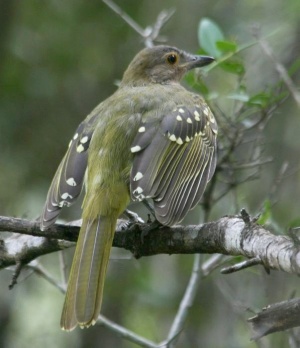- Nicator gularis
Identification
These long-tailed, heavy billed, olive-grey birds have conspicuous and unique large yellow spots on the wing coverts.
Distribution

Photo by Alan Manson
Mkhuze Game Reserve, KwaZulu-Natal, South Africa, May 2008
Eastern coastal forests of Africa from southern Somalia to eastern South Africa, extending inland to riparian forest, dense woodland and sand forest in South Africa, eSwatini, Mozambique, Zimbabwe, Zambia, Malawi, Tanzania, Kenya, and Somalia.
Taxonomy
There remains some argument about the grouping of the Nicator genus with some authorities (Clements, 2007) placing it with the Bulbuls (Pycnonotidae) whereas others group it with the Bush-shrikes (Malaconotidae). Beresford et al. (2005) found that molecular evidence shows that Nicator is not closely related to either group, and they suggest that the three species are best placed in their own family.
This is a monotypic species[1].
Habitat
Dense coastal forest, larger riparian woodlands, sand forest, dense woodland and scrub.
Behaviour
Despite being fairly common it is secretive and shy, foraging in densely tangled undergrowth or lower branches.
Diet
Food is mainly insects taken in the canopy, in low vegetation and on the ground. Like the Fork-tailed Drongo, it will follow large mammals, feeding on flushed insects; also known to glean ticks from Warthog, Nyala, Impala, Zebra and Red Duiker.
Breeding
Monogamous and territorial. The nest is a platform of stalks, tendrils and twigs with a shallow cup; it is not woven like the nest of a Bulbul. It is usually well-concealed, and about one metre above the ground. Two to three eggs are laid November to January.
Vocalisation
It is highly vocal, singing from concealed perches; it is a species which frequently mimics other forest species.
Gallery
Click on image to see larger version
References
- Clements, JF. 2011. The Clements Checklist of Birds of the World. 6th ed., with updates to August 2011. Ithaca: Cornell Univ. Press. ISBN 978-0801445019. Spreadsheet available at http://www.birds.cornell.edu/clementschecklist/downloadable-clements-checklist
- Beresford P, Barker FK, Ryan PG & Crowe TM. 2005. African endemics span the tree of songbirds (Passeri): molecular systematics of several evolutionary ‘enigmas’. Proc. R. Soc. B 272, 849–858.
- Hockey, PAR, WRJ Dean, and PG Ryan, eds. 2005. Roberts' Birds of Southern Africa. 7th ed. Cape Town: John Voelcker Bird Book Fund. ISBN 978-0620340533
- Sinclair, I and P Ryan. 2003. Birds of Africa South of the Sahara. Princeton: Princeton Univ. Press. ISBN 978-0691118154
Recommended Citation
- BirdForum Opus contributors. (2025) Eastern Nicator. In: BirdForum, the forum for wild birds and birding. Retrieved 11 May 2025 from https://www.birdforum.net/opus/Eastern_Nicator
External Links
GSearch checked for 2020 platform.1





